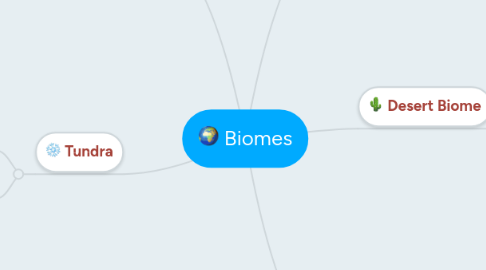
1. Forest Biome
1.1. Tropical
1.1.1. 77° Fahrenheit Average & Lots of Rain
1.1.1.1. Elephant & King Cobra
1.1.1.1.1. Bamboo & Jambu
1.2. Temperate
1.2.1. Two distinct seasons. One is long and wet, and the other is a short, dry and foggy summer.
1.2.1.1. Mountain Lion & Elk
1.2.1.1.1. Fire Weed 7 Western Skunk
1.3. Boreal Forests (taiga)
1.3.1. Average annual temperatures from about +5° to -5° C.
1.3.1.1. Porcupine & BobCat
1.3.1.1.1. Pine Cone & Moss
2. Tundra
2.1. Arctic
2.1.1. Frozen Land
2.1.1.1. Polar Bear & Arctic Wolf
2.1.1.1.1. Bearberry & Arctic Moss
2.2. Alpine
2.2.1. 12 degrees Celsius to 10 degrees Celsius
2.2.1.1. Alpaca & Snow Leopard
2.2.1.1.1. Bear Grass & Wild Potato
3. Aquatic Biome
3.1. Fresh Water
3.1.1. Varies Based on Location
3.1.1.1. Otters & Birds
3.1.1.1.1. Lily Pads & Duck Weed
3.2. Marine
3.2.1. Varies Based on Location
3.2.1.1. Crustaceans & Whales
3.2.1.1.1. Algae & Coral Reefs
4. Desert Biome
4.1. Hot and Dry
4.1.1. Average temperatures over 64° F.
4.1.1.1. Coyote & Javalina
4.1.1.1.1. Barrel Cactus & Palo Verde
4.2. Cold
4.2.1. Snow in the Winter
4.2.1.1. Deer & Pocket Mice
4.2.1.1.1. Lichens & Leaves
4.3. Coastal
4.3.1. Moderately cool to warm areas.
4.3.1.1. Toads & Birds
4.3.1.1.1. Black Sage & Rice Grass
4.4. Semiarid
4.4.1. Summers are moderately long and dry, and like hot deserts, the winters normally bring low concentrations of rainfall.
4.4.1.1. Insects & Jack Rabbits
4.4.1.1.1. Jujube & CatClaw
5. Grassland Biome
5.1. Temperate Grassland
5.1.1. The summers are hot and the winters are cold.
5.1.1.1. Bison & Golfers
5.1.1.1.1. Wild Oats & Rye Grass
5.2. Savanna
5.2.1. Wet/dry climate.
5.2.1.1. Emu & Lion
5.2.1.1.1. Whistling Thorn & Baobab
5.3. Steppes
5.3.1. Dry & Cold
5.3.1.1. Saker Falcon & Steppe Fox
5.3.1.1.1. Rhubarb & MilkFetch
